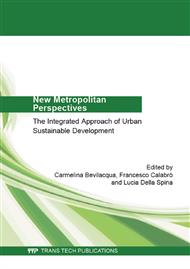[1]
L. van den Berg, J. van der Borg, J. Van der Meer: Urban Tourism: Performance and strategies in eight European cities, Aldershot, Avebury (1995).
Google Scholar
[2]
A. Martelli: Attrattività di sistema e fattori geografici: riflessioni su un dibattito in corso, in: P. Dubini, L'attrattività del sistema Paese: Territori, Settori, Imprese, Il Sole 24 Ore, Milano (2006).
Google Scholar
[3]
M. G. Caroli: Il Marketing Territoriale. Strategie per la Competitività Sostenibile del Territorio, Franco Angeli, Milano (2006).
Google Scholar
[4]
S. Barile: L'approccio sistemico vitale per lo sviluppo del territorio, in: Sinergie, 84, (2011), pp.48-87.
DOI: 10.7433/s108.2019.10
Google Scholar
[5]
S. Briggs: Successful Tourism Marketing: A Practical Handbook, Kogan Page Ltd, London (2001).
Google Scholar
[6]
M. Wheeler: Tourism Marketing Ethics: An Introduction, in: International Marketing Review 12 (4), (1995), pp.38-49.
DOI: 10.1108/02651339510097720
Google Scholar
[7]
P. Kotler et alia: Marketing Places Europe, Pearson Education Ltd, London (1999).
Google Scholar
[8]
M. Krantz, L. Schätzl: Marketing the city, in: European Cities in Competition, Ashgate Publishing Company, Avebury, (1997), pp.468-493.
Google Scholar
[9]
P. Kotler, D. Gertner: Country as brand, product, and beyond: A place marketing and brand management perspective, in: Brand Management, Vol. 9, n. 4-5, (2002), pp.249-261.
DOI: 10.1057/palgrave.bm.2540076
Google Scholar
[10]
R. Butler: The tourism area life cycle: Conceptual and theoretical issues, vol. 2, Channel View Publications, Clevedon (2006).
Google Scholar
[11]
C. Ventura: Vision or Invasion? Immagine, immaginazione e promozione nella tutela del patrimonio culturale, in: A. Bianco (ed. ), Articolo 9, Aracne Roma (2013).
Google Scholar
[12]
D. Getz, Event studies: Theory, research and policy for planned events, Elsevier, Oxford (2007).
Google Scholar
[13]
J. Ap, J. L. Crompton: Developing and testing a tourism impact scale, in: Journal of Travel Research, 37-2, (1998), pp.120-131.
DOI: 10.1177/004728759803700203
Google Scholar
[14]
J. P. A. Burns, T. J. Mules: An Economic Evaluation of the Adelaide Grand Prix, in: G.J. , Syme et alia, The Planning and Evaluation of Hallmark Events, Aldershot, Avebury, (1986), pp.172-185.
Google Scholar
[15]
F. Calabrò, L. Della Spina: The cultural and environmental resources for sustainable development of rural areas in economically disadvantaged contexts. Economic-appraisals issues of a model of management for the valorisation of public assets, in: 3rd International Conference on Energy, Environment and Sustainable Development (ICEESD 2013). Advanced Materials Research Vols. 869-870 (2014).
DOI: 10.4028/www.scientific.net/amr.869-870.43
Google Scholar
[16]
E. Grotberg: The International Resilience Project: Research and application, in: Proceedings of the 53rd Annual Convention, International Council of Psychologists: Cross-cultural encounters, E. Miao (Ed) General Innovation Service, Taipei (1996).
Google Scholar
[17]
R. Martelloni: Nuovi territori. Riflessioni e azioni per lo sviluppo e la comunicazione del turismo culturale, Franco Angeli, Milano (2007).
Google Scholar
[18]
S. Cherubini et alia: Il valore degli eventi, Franco Angeli, Milano (2009).
Google Scholar
[19]
G. Cassalia, M. Malaspina, C. Ventura: La valorizzazione integrata del mosaico paesistico-culturale nello Stretto: Il progetto sperimentale Ecodistretto, in: Utopias and dystopias in landscape and cultural mosaic. Visions Values Vulnerability - Proceedings of the International Scientifical Conference, Udine, June 27th - 28th, (2013).
Google Scholar
[20]
G. Cassalia, C. Ventura: Festivals, tourism and rural development: A key for cultural heritage preservation. A case study in the Gallico Valley, in: Conference Proceedings Active Countryside Tourism, International Centre for Research in Events, Tourism and Hospitality (ICRETH) Leeds Metropolitan University (2013).
Google Scholar
[21]
G. Cassalia, C. Ventura: Cultural landscape preservation as key factor for rural tourism, in: Conference Proceedings Tourism and the Shifting Values of Cultural Heritage, Visiting Pasts, Developing Futures, International Conference, Taipei, Taiwan (2013).
Google Scholar
[22]
J.E. Lozato-Fletcher: Input-Output Analysis and Tourism Impact Studies, in: Annals of Tourism Research, 16(4), (1989), pp.514-529.
DOI: 10.1016/0160-7383(89)90006-6
Google Scholar
[23]
L. Dwyer et al.: A Framework for Assessing Tangible and Intangible Impacts of Events and Conventions, in: Event Management, 6-3, (2000), pp.175-189.
DOI: 10.3727/096020197390257
Google Scholar
[24]
C. Ventura: Evaluation of the Socio-economic impact of cultural tourism and heritage marketing. The Input-Output analysis applied on tourism, Ed. Centro Stampa Ateneo, Reggio Calabria (2011).
Google Scholar


